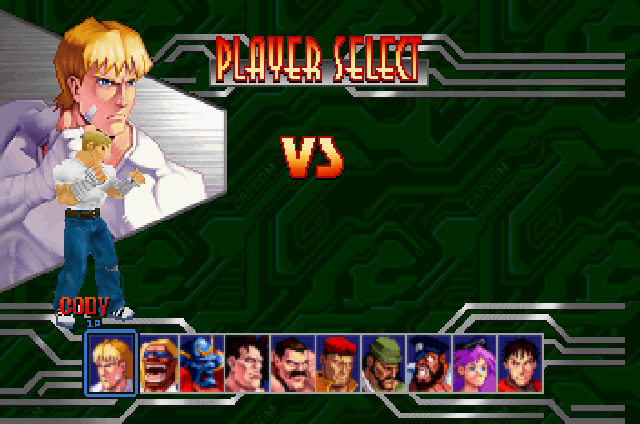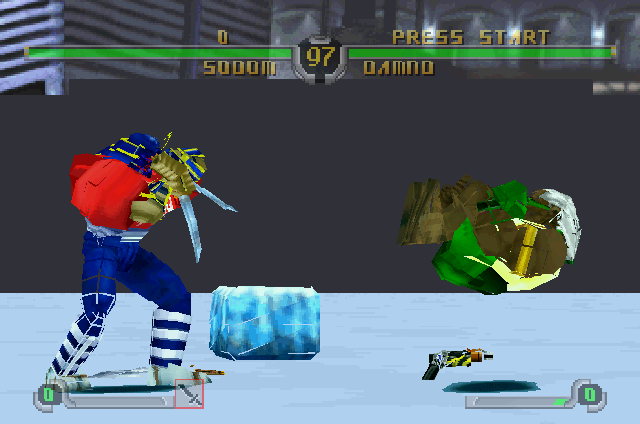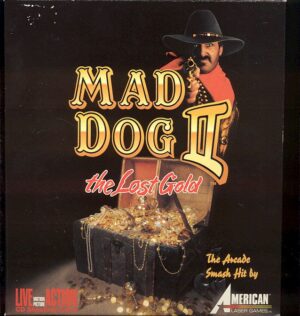Retro Replay Review
Gameplay
Final Fight Revenge shifts the traditional side-scrolling brawling action of the series into a one-on-one 3D fighter, pitting ten familiar faces from the Metro City saga against each other. You can choose from returning heroes Guy, Cody, and Mayor Mike Haggar, alongside Mad Gear lieutenants like Rolento and Poison, lesser-known bruisers such as El Gado and Andore, and the four towering bosses—Damnd, Sodom, Edi E., and finally a zombified Belger. Each battle unfolds across polygonal arenas that allow for sidesteps and ring-outs, offering a distinct twist on the franchise’s traditional combat.
Controls rely on two punch buttons, two kick buttons, and a special move button. Holding the special button while pressing up or down lets you sidestep into the foreground or background, adding a tactical layer to spacing and counters. The same button also picks up and tosses a variety of weapons—lead pipes, machine guns, even a flamethrower—so you’re constantly balancing your hand-to-hand combos with opportunistic grabs and throws.
Beyond basic attacks, each character has grappling techniques for grabs and throws, and a trio of Super Moves activated once you fill your gauge. Timing these cinematic attacks can turn the tide of battle, but you’ll need to manage your meter carefully—waste it too early and you’re left vulnerable, hoard it too long and you might not get the chance to unleash it. The arcade-to-Saturn conversion preserves this risk-reward mechanic faithfully, making for intense matches whether you’re dueling against the CPU or a friend.
Graphics
As the final Saturn release in Japan, Final Fight Revenge shows off the system’s 3D polygon capabilities in a way that few other titles did. Character models are bulky and angular by modern standards, yet they capture the larger-than-life proportions that the series is known for. Each fighter’s sprite has been translated into a fully rotating model, complete with signature costumes and exaggerated muscle definition.
The backgrounds rely on pre-rendered backdrops combined with simple 3D elements for environmental details—like flickering streetlights, moving vehicles, and the occasional destructible object. While textures appear blurry up close and draw distance can be limited, the stages effectively evoke the seedy alleys, rooftops, and industrial zones of Metro City. Animations are generally smooth, though you may spot occasional slowdowns when multiple particle effects (smoke, flamethrower bursts, flying debris) appear on screen.
Compared to contemporaries on other platforms, the visuals may seem dated, but they hold a nostalgic charm. The art direction relies more on bold color palettes and iconic character silhouettes than high-resolution textures. For Saturn collectors and retro enthusiasts, the polygonal arenas and visible frame rate hiccups are part of the home console’s unique quirks, rather than unforgivable flaws.
Story
The narrative premise is refreshingly straightforward: the Mad Gear gang is terrorizing Metro City once again, and it’s up to the same roster of fighters to restore order. There are no elaborate cutscenes or branching missions—your path is a linear gauntlet of six CPU opponents, culminating in a final showdown with a reanimated Belger. Fans of the original Final Fight will appreciate this direct sequel approach, even if it leaves little room for plot twists.
Between fights, each character delivers a brief one-off line or visual flourish that hints at their personality—Haggar’s stoic defiance, Cody’s cocky taunts, Poison’s coy flirting—yet these moments are fleeting. There’s minimal narrative cohesion tying the matchups together, so you’ll find yourself filling in backstory through imagination or series lore rather than in-game exposition.
Though sparse, the storyline serves its purpose by motivating the match progression: defeat Damnd, then Sodom, then face whichever antagonist follows. The zombie Belger finale adds a tongue-in-cheek nod to the series’ history—transforming the original game’s final boss into a horrifying version of himself—but don’t expect a deep, cinematic experience. The emphasis remains squarely on arcade action rather than dramatic storytelling.
Overall Experience
Final Fight Revenge is a unique entry in Capcom’s beat ’em-up legacy, offering a blend of familiar brawler mechanics with one-on-one fighting conventions. Its strength lies in fan service—seeing beloved and despised characters clash in polygonal ring-outs—and in its weapon-driven, multi-gauge combat system. Matches can be fast-paced and brutal, especially when a well-timed Super Move lands against an unprepared foe.
However, the transition to 3D comes with compromises: arenas feel cramped, camera angles can be awkward, and the roster balance isn’t as tight as dedicated fighting-game juggernauts of the era. Newcomers expecting a Street Fighter-level experience might find the controls a bit stiff and the combo potential limited. On the other hand, Saturn aficionados and hardcore Final Fight devotees will appreciate the novelty of this late-life experiment.
In the broader context of retro gaming collections, Final Fight Revenge stands out as a curious historical footnote—a title that closed the curtain on the Saturn in Japan and remains the only home-console 3D Final Fight spin-off for years to come. If you’re chasing completist status, seeking nostalgia, or simply intrigued by this oddball fighter, it offers enough spectacle and character variety to warrant at least one look. Just be prepared for a compact, arcade-style romp rather than a sprawling narrative adventure.
 Retro Replay Retro Replay gaming reviews, news, emulation, geek stuff and more!
Retro Replay Retro Replay gaming reviews, news, emulation, geek stuff and more!







Reviews
There are no reviews yet.